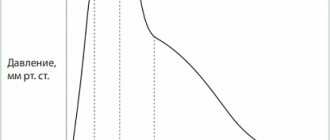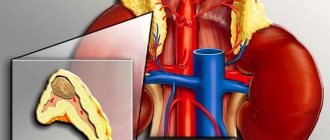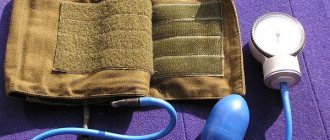KO-PERINEVA
special instructions
Co-Perineva®
Lithium preparations:
The simultaneous use of Co-Perineva® with lithium preparations is not recommended.
Renal dysfunction
| Therapy with Co-Perineva® is contraindicated in patients with severe renal failure (creatinine clearance less than 30 ml/min). In some patients with arterial hypertension without previous renal impairment, signs of acute renal failure may appear during therapy with Co-Perineva®. |In this case, treatment with Co-Perineva® should be discontinued. In the future, you can resume combination therapy using low doses of Co-Perineva®, or use perindopril and indapamide in monotherapy.
Such patients require regular monitoring of potassium and creatinine levels in the blood serum every 2 weeks after the start of therapy and every subsequent 2 months of therapy with Co-Perineva®.
Acute renal failure often develops in patients with severe CHF or underlying renal impairment, including bilateral renal artery stenosis or arterial stenosis of a single functioning kidney.
Taking Co-Perineva® is not recommended for patients with bilateral renal artery stenosis or stenosis of the artery of a single functioning kidney.
Decreased blood pressure and water-electrolyte imbalance
Hyponatremia is associated with a risk of a sudden decrease in blood pressure (especially in patients with bilateral renal artery stenosis or arterial stenosis of a single functioning kidney). Therefore, during dynamic monitoring of patients, attention should be paid to possible symptoms of dehydration and a decrease in the content of electrolytes in the blood plasma, for example, after prolonged diarrhea or vomiting. Such patients require regular monitoring of plasma electrolytes. With a pronounced decrease in blood pressure, intravenous administration of 0.9% sodium chloride solution may be required.
Transient arterial hypotension is not a contraindication for further continuation of therapy. After restoration of blood volume and blood pressure, you can resume therapy with Co-Perineva®, using low doses of the drug, or using the drugs perindopril and indapamide in monotherapy.
Potassium content
The combined use of perindopril and indapamide does not prevent the development of hypokalemia, especially in patients with diabetes mellitus or renal failure. As in the case of the combined use of antihypertensive drugs and a diuretic, regular monitoring of potassium levels in the blood plasma is necessary.
Excipients
It should be taken into account that the excipients of the drug Co-Perineva® include lactose monohydrate, therefore the drug is contraindicated in patients with hereditary galactosemia, lactase deficiency, and glucose-galactose malabsorption. (see section "Contraindications")
Perindopril
Neutropenia/agranulocytosis
In patients taking ACE inhibitors, cases of neutropenia/agranulocytosis, thrombocytopenia and anemia may develop. In patients with normal renal function in the absence of other complications, neutropenia rarely develops and resolves spontaneously after discontinuation of ACE inhibitors.
Perindopril should be used with great caution in patients with connective tissue diseases and simultaneously receiving immunosuppressive therapy, allopurinol or procainamide, especially with existing renal impairment. These patients may develop severe infections that do not respond to intensive antibiotic therapy. If perindopril is prescribed, it is recommended to periodically monitor the number of leukocytes in the blood. The patient should be warned that if any signs of an infectious disease appear (sore throat, fever), consult a doctor immediately.
Hypersensitivity/angioedema (Quincke's edema)
When taking ACE inhibitors, including perindopril, in rare cases, the development of angioedema of the face, lips, tongue, uvula, and/or larynx may occur. If these symptoms appear, the drug should be stopped immediately, and the patient should be observed until the signs of edema disappear completely.
If angioedema affects only the face and lips, its symptoms usually resolve on their own, or antihistamines can be used to treat the symptoms. Angioedema, accompanied by swelling of the tongue or larynx, can lead to airway obstruction and death.
If such symptoms appear, epinephrine (adrenaline) should be immediately administered subcutaneously (diluted 1:1000 (0.3 or 0.5 ml) and/or the airway should be secured.
Patients with a history of angioedema not associated with taking ACE inhibitors may have an increased risk of developing it when taking drugs of this group.
In rare cases, angioedema of the intestine develops during ACE inhibitor therapy. In this case, patients experience abdominal pain as an isolated symptom or in combination with nausea and vomiting, in some cases without previous angioedema of the face and with a normal level of C1-esterase. The diagnosis is made using computed tomography of the abdominal cavity, ultrasound, or at the time of surgery. Symptoms disappear after stopping ACE inhibitors. In patients with abdominal pain receiving ACE inhibitors, the possibility of developing angioedema of the intestine must be taken into account when making a differential diagnosis.
Anaphylactoid reactions during desensitization procedures
There are isolated reports of the development of long-term, life-threatening anaphylactoid reactions in patients receiving ACE inhibitors during desensitizing therapy with the venom of hymenoptera insects (bees, wasps). ACE inhibitors should be used with caution in patients prone to allergic reactions undergoing desensitization procedures. Prescription of an ACE inhibitor should be avoided in patients receiving immunotherapy with hymenoptera venom. However, the development of anaphylactoid reactions can be avoided by temporarily discontinuing the ACE inhibitor at least 24 hours before the start of the desensitization procedure.
Anaphylactoid reactions during LDL apheresis
In rare cases, life-threatening anaphylactoid reactions may occur in patients receiving ACE inhibitors during LDL apheresis using dextran sulfate. To prevent an anaphylactoid reaction, ACE inhibitor therapy should be discontinued before each LDL apheresis procedure using high-flux membranes.
Hemodialysis
Anaphylactoid reactions have been reported in patients receiving ACE inhibitors during hemodialysis using high-flux membranes (eg, AN69®). Therefore, it is advisable to use a different type of membrane or use an antihypertensive drug of a different pharmacotherapeutic group (see section “With caution”).
Potassium-sparing diuretics and potassium supplements
The combined use of perindopril and potassium-sparing diuretics, as well as potassium preparations and potassium-containing table salt substitutes is not recommended.
Cough
During therapy with an ACE inhibitor, a dry cough may occur, which disappears after discontinuation of drugs in this group. If a dry cough appears, you should be aware of the possible connection of this symptom with taking an ACE inhibitor. If the doctor believes that ACE inhibitor therapy is necessary for the patient, taking Co-Perineva® can be continued.
Children and adolescents under 18 years of age
The drug Co-Perineva® is contraindicated in children and adolescents under 18 years of age due to the lack of data on the effectiveness and safety of use.
Risk of arterial hypotension and/or renal failure in patients with CHF, water and electrolyte imbalance, etc.)
In liver cirrhosis, accompanied by edema and ascites, arterial hypotension, and CHF, significant activation of the renin-angiotensin-aldosterone system (RAAS) may be observed, especially with severe hypovolemia and a decrease in the content of electrolytes in the blood plasma (against the background of a salt-free diet or long-term use of diuretics).
The use of an ACE inhibitor causes blockade of the RAAS, and therefore a sharp decrease in blood pressure and/or an increase in the concentration of creatinine in the blood plasma is possible, indicating the development of acute renal failure, which is more often observed when taking the first dose of Co-Perineva® or during the first two weeks of therapy .
Elderly patients
Before starting to take Co-Perineva®, renal function and potassium levels in the blood plasma should be assessed. The initial dose of Co-Perineva® is selected depending on the degree of reduction in blood pressure, especially with a decrease in blood volume and heart failure (functional class IV according to the NYHA classification). Such measures help to avoid a sharp decrease in blood pressure.
Atherosclerosis
The risk of arterial hypotension exists in all patients, however, special caution should be observed when using the drug Co-Perineva® in patients with coronary heart disease and cerebrovascular insufficiency. In such patients, treatment should begin with a dose of 0.625 mg/2 mg of Co-Perineva® (initial dose).
Patients with renovascular hypertension
Treatment with Co-Perineva in patients with diagnosed or suspected renal artery stenosis should begin in a hospital setting with a dose of Co-Perineva® 0.625 mg/2 mg, monitoring renal function and potassium levels in the blood plasma. Some patients may develop acute renal failure, which is reversible after discontinuation of the drug.
Other risk groups
In patients with CHF (functional class IV according to the NYHA classification) and patients with type 1 diabetes mellitus (risk of spontaneous increase in potassium levels), treatment should begin with an initial dose of 0.625 mg/2 mg of Co-Perineva® and under medical supervision.
Patients with diabetes mellitus
When prescribing Co-Perineva® to patients with diabetes mellitus receiving oral hypoglycemic agents or insulin, blood glucose concentrations should be regularly monitored during the first month of therapy.
Ethnic characteristics
Perindopril (like other ACE inhibitors) has a less pronounced hypotensive effect in patients of the Negroid race compared to representatives of other races.
Surgical interventions/General anesthesia
The use of ACE inhibitors in patients undergoing surgery using general anesthesia may lead to a significant decrease in blood pressure, especially when using general anesthesia agents that have a hypotensive effect.
It is recommended to stop taking ACE inhibitors, including perindopril, 12 hours before surgery, warning the anesthesiologist about the use of ACE inhibitors.
Aortic stenosis/Mitral stenosis/Hypertrophic obstructive cardiomyopathy
ACE inhibitors should be used with caution in patients with left ventricular outflow tract obstruction and aortic and/or mitral stenosis.
Liver failure
In rare cases, cholestatic jaundice occurs while taking ACE inhibitors, and as it progresses, fulminant liver necrosis develops, sometimes with death. If jaundice or a significant increase in the activity of “liver” transaminases occurs while taking ACE inhibitors, taking Co-Perineva® should be discontinued.
Anemia
Anemia can develop in patients after kidney transplantation or in patients on hemodialysis.
Hyperkalemia
May develop during treatment with ACE inhibitors, including perindopril. Risk factors for hyperkalemia are renal failure, old age, diabetes mellitus, some concomitant conditions (decrease in blood volume, acute heart failure in the stage of decompensation, metabolic acidosis), simultaneous use of potassium-sparing diuretics (such as spironolactone, eplerenone, triamterene, amiloride), as well as drugs potassium or potassium-containing substitutes for table salt and the use of other drugs that increase the content of potassium in the blood plasma (for example, heparin). Hyperkalemia can cause serious heart rhythm problems, sometimes fatal. The combined use of the drugs listed above must be carried out with caution.
Indapamide
Photosensitivity
There are reports of cases of increased photosensitivity while taking thiazide and thiazide-like diuretics. If a photosensitivity reaction develops while taking Co-Perineva®, treatment should be discontinued. If there is a need to resume use of the drug Co-Perineva®, you should protect exposed skin from direct exposure to sunlight and artificial ultraviolet rays.
Water and electrolyte balance
Sodium content in blood plasma
|Before starting treatment with Co-Perineva®, it is necessary to determine the sodium content in the blood plasma and, while taking the drug, regularly monitor electrolytes in the blood plasma. All diuretics can cause hyponatremia, leading to serious complications.
Potassium content in blood plasma
Therapy with thiazide and thiazide-like diuretics is associated with a risk of developing hypokalemia (less than 3.4 mmol/l) in the following patients: elderly, malnourished patients, patients with liver cirrhosis, patients with peripheral edema, ascites, coronary heart disease, CHF. Hypokalemia in these patients enhances the toxic effect of cardiac glycosides and increases the risk of developing arrhythmia.
The high-risk group includes patients with an increased QT interval on the ECG.
Hypokalemia, like bradycardia, contributes to the development of severe heart rhythm disturbances, especially arrhythmias, which can be fatal. In all the described cases, regular monitoring of potassium levels in the blood plasma is necessary. The first determination of potassium content in the blood plasma should be carried out within the first week from the start of therapy with Co-Perineva®.
Calcium content in blood plasma
Thiazide and thiazide-like diuretics reduce the excretion of calcium by the kidneys, leading to a slight and temporary increase in calcium levels in the blood plasma. Severe hypercalcemia may be a consequence of latent hyperparathyroidism. Before studying the function of the parathyroid glands, you should stop taking Co-Perineva®.
Plasma glucose concentration
Glucose concentrations should be monitored in patients with diabetes mellitus.
Uric acid
In patients with increased concentrations of uric acid in the blood plasma during therapy with Co-Perineva®, the frequency of exacerbations of gout may increase.
Diuretics and kidney function
Hypovolemia as a result of a decrease in blood volume or hyponatremia caused by taking diuretics at the beginning of treatment with Co-Perineva® can lead to a decrease in glomerular filtration rate I and be accompanied by an increase in concentration; creatinine and urea in blood plasma.
Athletes
Indapamide may give a false-positive reaction during doping control.
Pharmacodynamics and pharmacokinetics
Co-Perineva is a combination drug containing perindopril and indapamide .
The drug has an antihypertensive effect, the effectiveness of which does not depend on the patient’s age, body position, and is not accompanied by tachycardia. Does not affect lipid metabolism, including in patients with diabetes . When taking the drug, the risk of hypokalemia .
The antihypertensive effect persists throughout the day.
After just a month of taking the drug, a decrease in blood pressure is achieved. If treatment is stopped, there is no risk of withdrawal syndrome .
Perindopril is extremely effective in the fight against arterial hypertension (all forms of severity). 4-6 hours after taking the medicine, the maximum antihypertensive effect develops, which lasts throughout the day.
Perindopril after administration is quickly absorbed from the gastrointestinal tract. Bioavailability is 65-70%. 3-4 hours after administration, the maximum level of the drug in the blood plasma is reached. It is metabolized in the liver, forming an active ( perindoprilat ) and five inactive metabolites. A small amount of perindoprilate passes into breast milk and through the placenta. Excreted through the kidneys.
The elimination of perindoprilate is slowed down in patients with heart and renal failure and patients over 65 years of age. In patients suffering from liver cirrhosis, hepatic clearance is reduced by half, however, the level of perindoprilate is not reduced.
Indapamide is almost completely absorbed from the gastrointestinal tract; simultaneous intake of food can slow down this process. After an hour, the maximum level in the blood is reached. Metabolized in the liver. Excreted through the kidneys and intestines.
Instructions for use (Method and dosage)
The medicine Co-Perineva is taken 1 time per day, orally, in the morning before breakfast, with water.
Doses are listed in the indapamine/perindopril ratio.
To begin with, you should take one tablet per day (0.625/2 mg). If it is not possible to achieve blood pressure control within a month, the dose is increased to one tablet (1.25/4 mg). To achieve the most pronounced effect, you should increase the daily dose to the limit - one tablet (2.5/8 mg).
For elderly patients, the initial dose is one tablet (0.625/2 mg). Treatment with the drug can be prescribed in case of control of blood pressure and kidney function.
Patients with moderate renal impairment are started on the lowest dose, with the maximum allowed dose being 1.25/4 mg.
Contraindications
The drug Co-Perineva is contraindicated in the following cases:
- sensitivity to any element of the drug;
- lactose intolerance;
- refractory hyperkalemia;
- angioedema;
- bilateral renal artery stenosis;
- lactase deficiency;
- liver failure;
- glucose-galactose malabsorption;
- renal failure;
- renal artery stenosis;
- pregnancy, lactation, children under 18 years of age.
You should take the drug with caution in the following cases:
- connective tissue diseases ( scleroderma , SLE );
- immunosuppressant therapy;
- inhibition of bone marrow hematopoiesis;
- angina pectoris;
- renovascular hypertension;
- decrease in blood volume;
- hyperuricemia;
- diabetes;
- cerebrovascular diseases.
Side effects
The use of the drug may cause the following side effects:
- thrombocytopenia , agranulocytosis , hemolytic anemia , leukopenia , aplastic anemia ;
- vertigo , paresthesia , dizziness, headache; unstable mood, sleep disturbance; in rare cases – confusion;
- tinnitus, blurred vision;
- orthostatic hypotension , arrhythmias ( bradycardia , atrial fibrillation , ventricular tachycardia ), myocardial infarction , angina pectoris ;
- dry cough , shortness of breath , bronchospasm, rhinitis , eosinophilic pneumonia ;
- dry mouth, constipation, nausea, abdominal pain, loss of appetite, epigastric pain, vomiting, diarrhea, dyspepsia, pancreatitis , jaundice ;
- angioedema (face, lips, limbs, here, tongue, larynx), rash, urticaria , itching;
- muscle spasms;
- renal failure;
- impotence;
- asthenia , increased sweating.
Overdose
Symptoms of overdose: vomiting , nausea, muscle cramps, drowsiness , dizziness, confusion, decreased water and electrolyte balance, oliguria , significant decrease in blood pressure.
If the above symptoms appear, you should rinse your stomach, then take activated charcoal to restore the water and electrolyte balance. If the pressure decreases significantly, the patient should lie on his back and raise his legs, then inject a 0.9% sodium chloride solution.
special instructions
It is not recommended to take it in parallel with lithium preparations .
Therapy is strictly contraindicated in patients with impaired renal function . Patients suffering from hypertension may experience symptoms of renal failure . In this case, you should stop treatment with Co-Perineva. Later, therapy can be repeated, prescribing minimal doses, or indapamide and perindopril can be used in monotherapy. These patients should have their blood creatinine and potassium
The combination of Indapamide and Perindopril cannot prevent the development of hypokalemia , especially in cases where the patient has diabetes mellitus or renal failure. In this case, the level of potassium in the blood must be monitored regularly.











